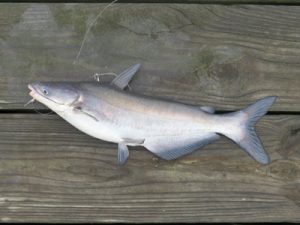The blue catfish is a large, invasive catfish species that has become established in the Chesapeake Bay watershed.

Adults have stout bodies with prominently humped back in front of the dorsal fin. The back and upper sides are blue to slate gray, and the lower sides and belly are white.
Young blue catfish have deeply forked tails similar to channel catfish, but lack spots and have a large straight edged anal fin.
The tail fins of blue catfish tend to become more rounded as they increase in size. Older specimens often have damaged or missing whiskers.
Blue catfish grow to over 55 inches long and can weigh over than 100 pounds, living 20-25 years.
Blue catfish are native to the Mississippi, Missouri, and Ohio river drainages.
In the 1970’s, blue catfish were introduced in the James, York, and Rappahannock rivers to establish recreational fisheries.
These non-native species have since spread, inhabiting nearly all major tributaries of the Chesapeake Bay watershed. Blue catfish have become a dominant species in the tidal James, Rappahannock, and York rivers.
The rapid range expansion and population growth of blue catfish has raised concerns about impacts on the ecology of the Chesapeake Bay.
Blue catfish are long-lived, fast growing, opportunistic feeders. They consume a variety of fish, crabs, mollusks, and other prey.
In the Chesapeake Bay, commercial fishermen harvest millions of pounds of blue catfish annually.
Blue catfish have been known to bioaccumulate mercury and other contaminants to levels that can impact human health. The Maryland Department of the Environment (MDE) and Virginia Department of Health (VDH) provide blue catfish consumption guidelines.
Related Information